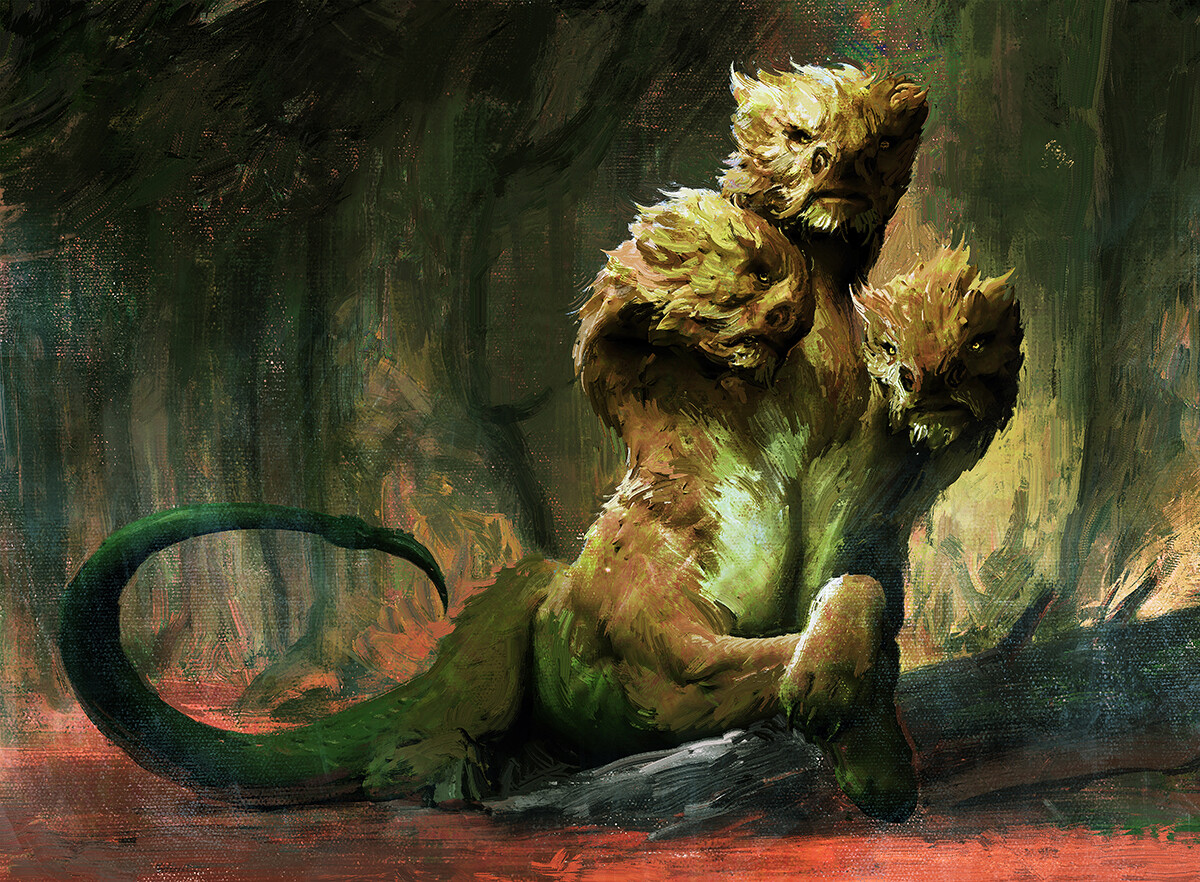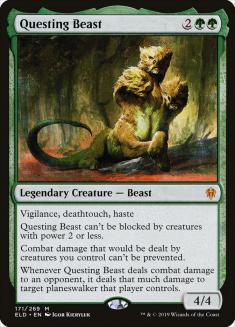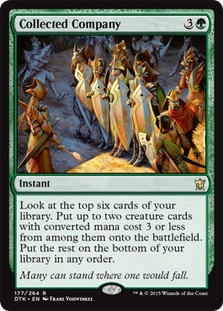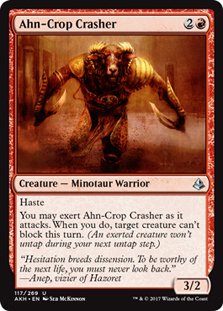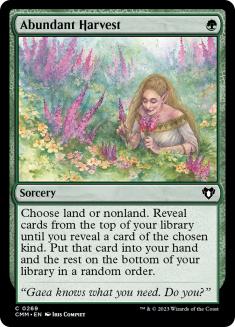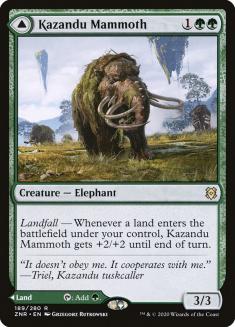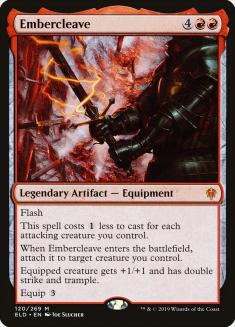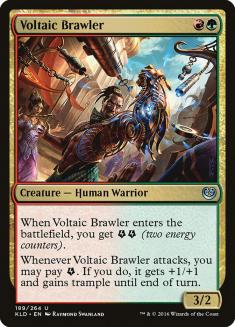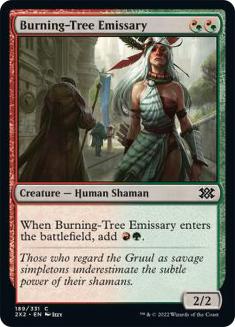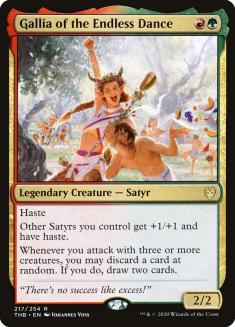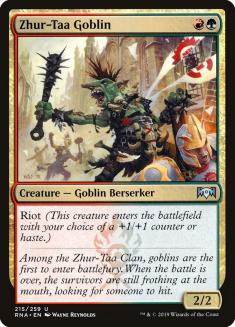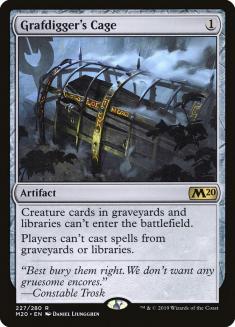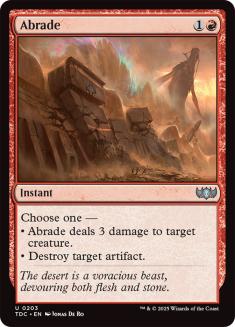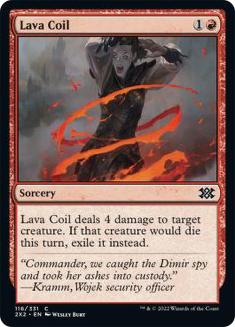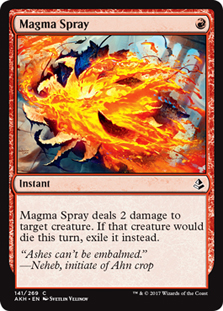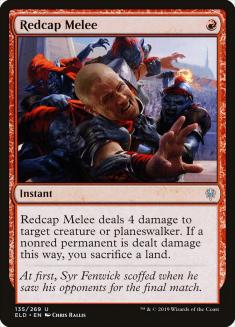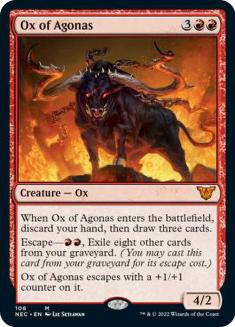Last Saturday was another Insights Esports Historic Open where 194 players battled it out, including several pro players. In the end, the winning deck was Rakdos Arcanist (Lurrus), but Gruul Aggro was the most successful deck of the tournament, with two copies in the Top 8; another in ninth (yours truly, unfortunately); and another in tenth. While this obviously doesn’t prove anything, four copies in the Top 10 is a strong indicator that Gruul Aggro is at least a viable deck again.
Personally, I think it makes sense. I’ve found a lot of success just trying to kill people in Historic, especially when the format is new and everyone is trying to be cute, and Gruul is an aggressive deck that gets to run removal and graveyard hate, so I definitely recommend it at this point.
There isn’t a lot of variation in most Gruul Aggro lists, but the few slots that do change from list to list are very important. Let’s talk about them:
Questing Beast VS Collected Company
When I played the deck in the January Kaldheim League Weekend, I was convinced Questing Beast was great and Collected Company was mediocre. This was mostly because I felt like when I played Gruul Aggro, I didn’t want any two creatures; I just wanted something that could attack meaningfully that turn; I wanted to kill them, not set up for killing them next turn if things went right.
Gruul Aggro has a ton of hits, but several of those hits just aren’t good — you don’t want to hit Llanowar Elves, Burning-Tree Emissary, or Pelt Collector at that stage of the game — and in the end you’re just getting 6/6 worth of stats or something. It’s very different from decks like Jund Company or Bant Angels, where you’re getting much more of your money’s worth because you’re completing some sort of synergy and even your bad hits (e.g. Cauldron Familiar) have uses.
This created a situation where Gruul Aggro was usually getting 6/6 or 7/7 worth of stats spread across two creatures, which is obviously reasonable, but simply not worth the times where you get 2/2 worth of stats or where you simply get nothing. I much preferred the guaranteed power of an immediately attacking, hard-to-block Questing Beast.
Nowadays, however, I’m not actually so sure about it. This is because of two things. The first is Ahn-Crop Crasher.
Ahn-Crop Crasher is Martin Juza’s piece of technology and it makes Collected Company ten times better, because it gives you something to actually look forward to — a card with a meaningful ability and meaningful impact in the game by the time you cast Company. Now, all of a sudden, you have eight three-power haste creatures to find, and one of them removes a blocker as well, which is a big swing.
This means you’re about 60% to find a haste creature, and about 17% to find two of them. Finding Ahn-Crop Crasher and Gruul Spellbreaker could reasonably result in ten added damage that turn. Note, however, that I take out Ahn-Crop Crasher a lot after sideboarding because the games become more grindy and it’s less of a race to just kill them.
The second reason is that Questing Beast is a bit worse now, because there are fewer Cauldron Familiars to theoretically block it. Part of the power of the card was dodging these scenarios, and if these scenarios are less common, it becomes easier to replace.
In the end, however, I’m still sticking with Questing Beast over Collected Company, because:
- 60% of a haste creature is still far less than 100% of a haste creature.
- Part of the strength of Collected Company is being able to cast it at instant speed, but you lose some of the value of this card in the deck if you do that, given how haste is a big thing.
- I’m not sure I want to play four Ahn-Crop Crashers and I think with maindeck Company you have to.
- Questing Beast still dodges some powerful things in the format — namely Eliminate and Shadows’ Verdict — and its third (Fourth? Fifth? Who can count those?) ability helps killing planeswalkers like Narset, Parter of Veils which are becoming increasingly more common.
So, basically, my conclusion is that Questing Beast is still better than Collected Company but that the gap is narrower than it was. If your metagame is particularly vulnerable to Ahn-Crop Crasher (it’s very good versus Orzhov Auras, for example), it might be reasonable to just play Company and maximize on that.
For the metagame I expect right now, I like Questing Beast. I still like Collected Company in the sideboard though, and for that you don’t even need the Ahn-Crop Crashers (you will see they come out sometimes Company comes in) because the goal isn’t killing them immediately but refueling after sweepers and through removal spells.
Abundant Harvest VS Kazandu Mammoth
Abundant Harvest has been making a lot of waves in Historic, and it’s natural to want to try it out in any deck that can support it. Michael Majors wrote about the card this week; while I agree with what he said about it being a powerful cantrip and especially a good combo with Brainstorm, I don’t agree with the people who are putting it in Gruul specifically.
Abundant Harvest is a strong cantrip — more powerful than Opt on value alone — but it’s still a cantrip, and Gruul is not interested in a cantrip. You would not play Opt in Gruul, but you would also not play Ponder, Preordain, or Brainstorm, because you’re simply not interested in paying tempo for added consistency. You want to curve people out and kill them rather than smoothing your draws.
In my mind, Abundant Harvest is comparable to Kazandu Mammoth — they are both a “tapped land” in some ways. Abundant Harvest can find red mana while Kazandu Mammoth cannot, but Kazandu Mammoth can be your first green land while Abundant Harvest can’t. When you cast Abundant Harvest, you pay one mana to find a spell. When you cast Kazandu Mammoth, you pay zero mana to draw Kazandu Mammoth. Kazandu Mammoth is not as good as “random spell in Gruul Aggro,” but is it not as good as “random spell in Gruul Aggro that you had to pay one extra mana for” also? I think it is.
Mammoth is better than any of your two-drops in most situations. For example, you’d rather cast a Mammoth than cast a Harvest into a Burning-Tree Emissary, let alone Harvest into Llanowar Elves most of the time, or Harvest into a three- or four-drop that you can’t cast this turn. The counterpart is that you can cast Harvest Turn 1 into a two-drop, and Mammoth can’t fill this spot in the curve (but at the same time it’s not a reliable two-drop, so you might keep an awkward hand hoping it gets you there and it won’t).
Overall, I think the power level of the cards is honestly close to a wash when you consider all those aspects. The main difference? Kazandu Mammoth gets hit by Collected Company. Given that Collected Company is the main reason to play Kazandu Mammoth to begin with, I’m not sure if Harvest even has a place. If you have Company in your deck, you certainly want Mammoth instead of Harvest, and if you don’t have Company, I’m not sure you want either of them. Not being able to curve out is a big problem. I would also not play four Kazandu Mammoths, so I don’t think you should play four Harvest even if you do want to play it, especially since Harvesting for Harvest is pretty bad in this deck and turns it into a two-mana cantrip. Right now, I’ve been happy with zero copies.
What About Embercleave?
I sideboard Embercleave out a fair bit, but I think it’s the best plan to have in Game 1 – it’s just the most important card and the best at goldfishing and beating blockers, and it completely swings matchups like Selesnya Company where you would otherwise struggle to attack. I think you just need to play four copies of this card.
The Two-Drops
Of the potential two-drops you can play, I think Burning-Tree Emissary and Scavenging Ooze fill unique roles, especially so now that graveyard strategies are so powerful. There’s no Uro, Titan of Nature’s Wrath anymore, but there are graveyard-based Emergent Ultimatum decks, Rakdos Arcanist decks, Arclight Phoenix decks, and even several control decks playing a Torrential Gearhulk shell. I think you should play a minimum of three Scavenging Oozes, but four is not out of the question given how good it is versus so much of the field.
This leaves the choice between the other three creatures for a strictly aggressive two-drop. I think Voltaic Brawler blows this competition away; it attacks for more damage (which can be doubly relevant with Embercleave) and has trample naturally, so it can get itself past chump blockers and is a prime target for Hashep Oasis. I don’t like Gallia very much as just a 2/2 haste, and the only reason in my mind to play Zhur-Taa Goblin instead of Voltaic Brawler is if you expect a lot of Cry of the Carnarium-type cards that will punish you for having two-toughness creatures specifically.
Right now, this is the list I would play:
Creatures (34)
- 4 Llanowar Elves
- 4 Scavenging Ooze
- 4 Burning-Tree Emissary
- 4 Voltaic Brawler
- 3 Ahn-Crop Crasher
- 4 Pelt Collector
- 4 Gruul Spellbreaker
- 2 Questing Beast
- 4 Bonecrusher Giant
- 1 Kazandu Mammoth
Lands (20)
Spells (6)
Sideboard

Matchups
VS Rakdos Arcanist (Lurrus)
This matchup is extremely snowbally and depends almost solely on how they draw. You’re very consistent at doing your thing and you’ll be able to kill them quickly every game, but their draws have a wide range. If they go Thoughtseize into Dreadhorde Arcanist into removal spell, for example, they’re just going to win because you’re not very well equipped to deal with that, but if they draw Young Pyromancer instead of Arcanist, for example, it’s already a different story and you can just Embercleave them out. This is a matchup where Questing Beast is very good, as it dodges both removal and blockers.
Out:
In:
I struggle with how much removal to bring in, because Arcanist is really important to kill, but you usually don’t want removal spells in a matchup like this where they have so much one-for-one removal. Cage does stop Arcanist, so I think this is enough, but perhaps it isn’t? Redcap Melee is better for killing Arcanist (and Young Pyromancer and Kroxa, Titan of Death’s Hunger), but it’s worse for killing Lurrus of the Dream-Den, and they always have access to Lurrus. Still, it’s possible that Redcap Melee ends up being better in this matchup (or it’s possible the sideboard should be configured so you can bring in a third Cage and not have to worry as much about removal).
VS Izzet / Temur Phoenix
I think this matchup is even-ish and, again, depends mostly on their draw because they have such a wide range. If they remove your first creature and put two Arclight Phoenixes onto the battlefield on Turn 3, you’re probably not going to win, but you do have very explosive draws that punish them for having a cantrip-heavy gameplan.
Out (VS no Arcanist, no Crackling Drake / the Stormwing Entity version):
In (VS no Arcanist, no Crackling Drake / the Stormwing Entity version):
Out (VS no Drake):
In (VS no Drake):
Out (VS no Arcanist):
In (VS no Arcanist):
Out (VS Arcanist and Drake):
In (VS Arcanist and Drake):
The sideboarding here is highly dependent on what version they’re playing and specifically what threats they are presenting. If Arclight Phoenix is their only graveyard card, I don’t like Grafdigger’s Cage — I only bring it in if they also have Arcanist (Magma Spray is a better Phoenix answer overall). If they have the x/4 Drakes, you want more ways to kill them. Regardless of the version they have, the matchup becomes more attrition-based (they have a lot more removal and Aether Gust most of the time), so Embercleave can become a liability. Collected Company is better because it just presents two threats they have to remove.
If this matchup becomes super-popular, you should play more Lava Coils (it’s the best answer, as it deals with everything) and more Collected Companies.
VS Mayhem Devil Decks
The matchup versus Mayhem Devil is very even (as you can tell, not many matchups are swingy with Gruul Aggro in Historic). The thing to be most careful about is running Embercleave into Claim the Firstborn — make sure you can either kill them or that you don’t die on the swing back. Sometimes it pays off to equip a smaller creature and deal less damage this turn just so you don’t die if it’s stolen.
Out:
In:
If they’re playing the Collected Company version, you can bring in the Grafdigger’s Cages as well, but against the Jund Food version I don’t think it’s good enough.
Vs Orzhov Auras (Lurrus)
This matchup is bad, but it’s not nearly as bad as Azorius Auras, because they have no lifegain. They will often make a big creature but you could theoretically go around it with a big swarm or simply Ahn-Crop Crasher it down. Couple that with the fact that you can actually kill their enablers and leave them off creatures and you definitely have a shot.
Out:
In:
Post-sideboard you get more of the good things – more Crashers, more ways to find Crasher, and more removal spells.
VS Gruul Aggro
The Gruul Aggro mirror is honestly extremely silly — whoever is on the play has a huge advantage. If they’re on the play and have a reasonable draw with Embercleave, you’re probably just going to lose and there’s nothing you can do about it.
Out (on the play):
In (on the play):
Out (on the draw):
In (on the draw):
You always go slower after sideboarding, but on the play I don’t think you need Magma Spray — you can just aggro them out and use your removal to clear blockers. On the draw, I think you need to be more reactive, so Sprays come in to kill their early plays.
This sideboarding strategy can change a lot depending on what they have — most people don’t have as much removal as I do, but if they also sideboard in all this stuff, you might want to have fewer Embercleaves and more Collected Companies to play a grindier game. If they have Elder Gargaroth, you’re going to need to keep all Ahn-Crop Crashers and just turn aggro on them because you’re not going to win the mid-game. If they have The Akroan War, you should take out Questing Beast, as it’s a beating to have that stolen.
VS Dimir Rogues
Dimir Rogues is a good matchup. It’s similar to how the matchup plays out in Standard except you’re a much faster deck here, so it’s hard for them to keep pace with you.
Out:
In:
After sideboarding you have to be careful about sweepers, but Ox is as good here as it is in Standard (maybe better since your curve is lower).
Moving Forward
Overall, I think Gruul Aggro remains a powerful Historic deck, and I would definitely recommend it in this wide-open metagame that we have in Historic right now. Let other people try to be tricky and instead just kill them on Turn 4 or Turn 5 every game.

